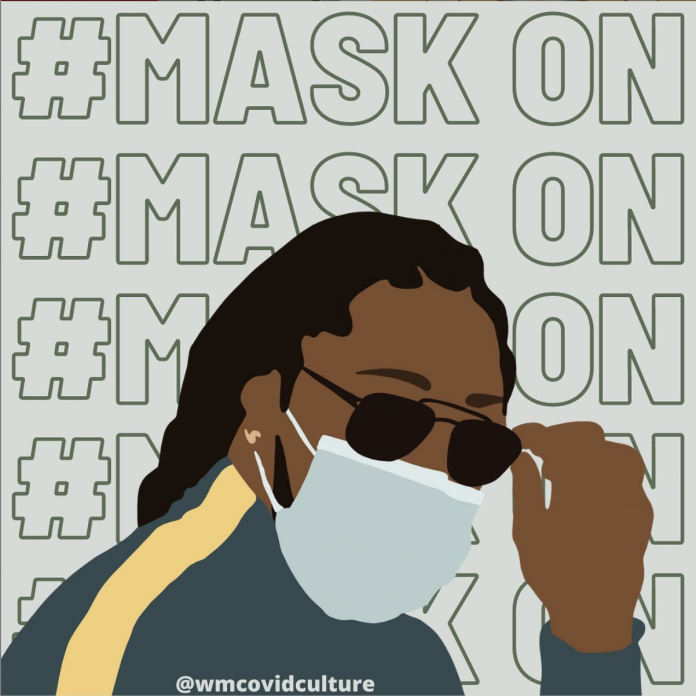COVID-19 has impacted life at the College of William and Mary in innumerable ways, touching daily life everywhere from classrooms and dining halls to student-run extracurricular activities and part-time jobs. But the novel virus’s consequences perhaps most directly fall on the shoulders of social life at the College — which has had to adapt significantly as students pursue social distancing, wear masks and limit large gatherings as mandated by the university.
To help their peers understand COVID-19’s ramifications for student life in Williamsburg and brainstorm creative ways of incorporating social distancing into their daily routines, five College students have launched a new social media campaign designed to facilitate these important conversations. Their account, @covidculture, has garnered more than 1,000 followers on Instagram since its creation in early August and features tips, graphics and advice for navigating campus life with safety and intentionality.
Sophia Hernandez ‘21 serves as @covidculture’s content head, and helped create the campaign alongside Solongo Bayarmaa ‘21, Allie Moyer ‘21, Henry Netter ‘23 and Olivia Koenig ‘22. Hernandez said the page was born from concerns over young adults’ adherence to social distancing and mask protocols this summer, especially given the lack of any formal etiquette for how to discuss COVID-19 safety with peers.
“During the summer, I noticed that many of my peers were not following social distancing whatsoever,” Hernandez said in an email. “As someone who comes from New Jersey (the second COVID-19 hotspot), I was trying to understand why they were blatantly disregarding this new way of life. I realized that the CDC gives us guidelines to socialize six feet apart and wear masks, but ignores the implications these guidelines have on all the intricate social interactions we have in everyday life. In other words, students didn’t incorporate social distancing into their routine because it’s just awkward, and there was no common etiquette.”
Hernandez decided to address this issue by dispelling the awkwardness surrounding social distancing procedures.
“…We realized that someone needed to spell out and help students visualize what a safe college experience looks like, before we get to campus,” Hernandez said. “We then gathered a couple of like-minded students, and got to work.”
Hernandez noted that the page’s engagement has sparked as students return to Williamsburg, with the bulk of its new followers originating from the College. However, students from other universities are also among those engaging with @covidculture’s content, demonstrating a nationwide demand among young adults for advice about how to successfully balance best health practices with social interaction.
Among @covidculture’s key objectives is conveying to students that abandoning social distancing and mask requirements while around your ‘quaranteam’ — a term used to describe a small group of friends that choose to neglect public health guidelines while in each other’s company — fails to take COVID-19’s spread and severity into account.
“We are mainly concerned about students making uninformed decisions that affect the safety of our community and the lack of a culture where social distancing is standard and personal health and safety boundaries are respected,” Hernandez said. “For example, people are using justifications such as “it’s just my quaranteam,” without considering the actual amount of people in the quaranteam based on households involved.”
The page’s content focuses on three main strategies for integrating social life and COVID-19 conscientiousness, employing different info graphics and arguments to articulate them. The first is to accurately convey how the virus spreads, which Hernandez said will help students as they seek to minimize exposure risks in social situations with their peers.
The second overarching tip is for students to map out their social interactions, keeping close account of who they interact with over time. Hernandez said that @covidculture highly recommends that individuals exercise caution with their friend groups, even with peers that have been safe around others.
Lastly, @covidculture encourages students to maintain their perspective throughout the fall semester, especially since many members of the College community, including immunocompromised students and faculty, face higher risks of developing severe symptoms. While adapting to new social situations may prove difficult, Hernandez emphasized that it is a labor of love that ultimately preserves the university community best.
“Remember why you are social distancing,” Hernandez said. “This is an inherently isolating time, and there will be a time when you are tempted to forgo all precautions. Remember that your actions directly affect yourself, those you love, and the community. You have a responsibility as a member of this community to protect those who cannot risk getting COVID-19.”
Furthermore, @covidculture exists to remind students that they can still have fun, make memories and meaningfully immerse themselves in campus life during the pandemic, provided they are willing to do so safely and creatively — a challenge the page is more than willing to meet.
“… you can still socialize, make memories, and have the same amount of fun, as long as it’s done safely,” Hernandez said. “Connections can still be created and strengthened; you just have to be creative.”

